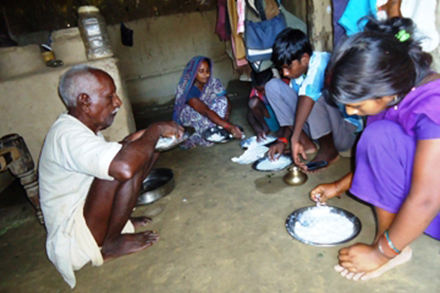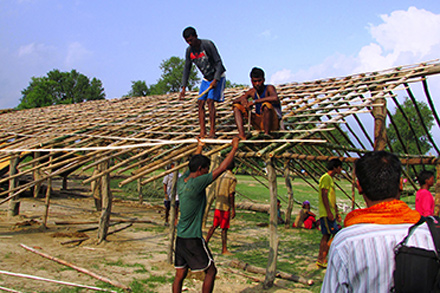When disaster hits a community, the poorest, weakest members are always the most vulnerable. The flood that hit Nepal this August was one of the strongest we have seen in many years. Heifer project areas in five districts were hit, affecting a staggering 14,000 households. Already weak structures, including granaries and homes, especially those made of mud, were completely destroyed. Concrete homes and livestock sheds were affected to a lesser degree. Collapsed bridges and impassable roads delayed the arrival of relief efforts.
On top of watching their property and loved ones being swept away in an instant, survivors had no way to meet their most basic needs: safe drinking water, nutritious food for their children, clean clothes.

With full force, the Rapti River entered the village of Fattepur. In an effort to save his family, one woman’s husband tried to lift his two daughters up to the roof of their house, but they couldn’t escape the river’s wrath. All three were engulfed and carried away as their helpless wife and mother looked on in horror. The woman hasn’t uttered a word since. Heifer Nepal staff found her outside the village’s police station with a relative who was trying to help her complete a missing persons report. Beyond her silence, there’s hope that her family will one day be reunited and complete again.
In the aftermath of this widespread flooding are too many stories like this–horrifying stores of loss, despair and struggle for survival. A shocked nation constantly checked for updates, as the number of deaths and property loss reported increased by the minute.
Your donation can help families recover from disaster.
Torrential rain and landslides collapsed bridges and decimated major roads. For the first few days, flood-struck villages were completely isolated from the rest of the world. Misery increased and hope diminished with each day that passed without desperately needed relief.
At a time when no outsider could reach the communities, they reached out to each other, bringing Sharing and Caring, one of Heifer’s 12 Cornerstones for Just and Sustainable Development, to life.
Members of four self-help groups in Kunathari village development committee (VDC) collected more than 660 pounds of rice and paddy, along with clothes, blankets, utensils, and other essentials. They carried these goods to their neighbors, 25 families who lost everything and were taking shelter in the community school.

The women of Tithireya VDC were affected by the flood, but that didn’t stop them from preparing food for others who seemed to be suffering even more.
When the Red Cross set up a relief distribution camp in Mohamadpur VDC, Heifer project families volunteered to hand out supplies.
Families living in Tulsipur VDC are now busy helping each other rebuild their homes.
Meanwhile, Heifer Nepal teamed up with its partners to assess the damages in the project areas. Tirelessly, they visited communities and made detailed notes of the extreme loss. They also became counselors, comforting those left behind, even though some of them had their own tragic flood stories. Project partner staff Dilli Chalise and Hira Lal Tamrakar served on Heifer’s assessment team. Both had just experienced personal loss from the flood.
Sundar Nepal Sanstha (or Beautiful Nepal Association), a project partner of Heifer Nepal, raised NPR 50,000, or about $500, and provided hygiene and sanitation items, including buckets, jugs, towels, soap, children’s clothing, chlorine tablets, toothpaste, toothbrushes, combs, sanitary pads and underclothes for families in Surkhet district.
With a dramatic rise in fever and flu cases, Heifer project partner NARCSC collaborated with the District Health Office in the city of Birendranagar to bring medical teams to perform checkups and provide appropriate medical care.
Following the government of Nepal’s one door policy for relief program, Heifer has provided a total of $50,000 to five Heifer districts affected by the flood. Although relief support is being entirely mobilized through the District Disaster Rehabilitation Center, Heifer’s network of partners, project management committees, cooperatives and self-help groups have been proactively facilitating the process to ensure that our families are receiving support.
These are just glimpses of how our partners and beneficiaries are working together to rebuild their lives. In Heifer communities, for each story of loss and despair there is another of courage and compassion. Our work is built on the foundation of strong social capital with a common value of the 12 Cornerstones shared by all of us connected with Heifer’s work. Together we will heal and together we will prosper.
Story by Alina Karki, Associate Communication Officer, Heifer Nepal. Photos courtesy of Heifer Nepal